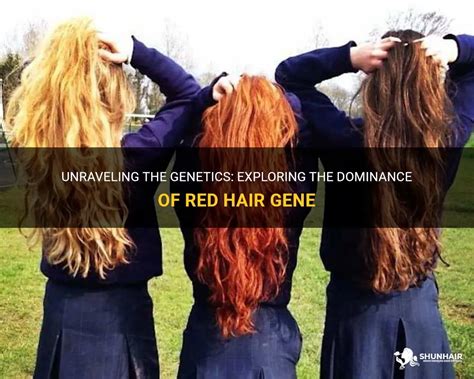Red hair, an audacious shade that has captivated imaginations and sparked wonder throughout history, is more than just a striking physical attribute. It is a testament to genetic diversity and a beacon of scientific intrigue.

The Genetics Behind the Red Hue
The presence of red hair is determined by a particular variant of the melanocortin 1 receptor (MC1R) gene. This gene regulates the production of melanin, the pigment responsible for skin, hair, and eye color. Individuals with two copies of the MC1R variant inherit red hair, while those with one copy have blonde or strawberry blonde hair.
Prevalence and Distribution
Red hair is a relatively rare trait, occurring in approximately 1-2% of the global population. However, its prevalence varies significantly across regions. Scotland, Ireland, and Wales lay claim to the highest concentrations of redheads, with around 10-15% of their populations sporting this vibrant hue.
Cultural Significance and Perceptions
Throughout history, red hair has been both revered and stigmatized. In ancient Egypt, redheads were considered symbols of fertility and fire. In medieval Europe, however, they were often associated with witchcraft and evil. Today, red hair is generally viewed positively, with many admiring its uniqueness and flair.
Health Implications
Studies have suggested that redheads may be more prone to certain health conditions. For example, they are more sensitive to pain, have a higher risk of developing skin cancer, and may experience a higher incidence of vitamin D deficiency.
Innovative Applications
The unique characteristics of red hair have inspired creative applications in various fields. For example, scientists have developed a device that uses red hair as a natural sunscreen. Additionally, the pigment responsible for red hair has potential applications in the development of new pharmaceuticals and cosmetics.
Common Mistakes to Avoid
When discussing red hair humans, it is essential to avoid certain common pitfalls:
- Generalizing: Not all redheads are the same. They come from diverse backgrounds and experiences.
- Stereotyping: Avoid attributing negative or positive traits to redheads based on their hair color.
- Oversimplifying Genetics: Red hair is not solely determined by a single gene variant. Other genetic and environmental factors also play a role.
Why Red Hair Matters
Red hair is not merely a cosmetic curiosity. It represents the remarkable diversity of human genetics and serves as a reminder of our interconnectedness. By understanding the biology and cultural significance of red hair, we gain a deeper appreciation for the intricate tapestry of human existence.
Benefits of Understanding Red Hair Humans
Exploring the enigmatic nature of red hair humans offers several benefits:
- Enhancing Cultural Sensitivity: Understanding the historical and cultural perceptions of red hair fosters empathy and respect for diverse individuals.
- Promoting Genetic Research: Studies on red hair contribute to our knowledge of human genetics and associated health conditions.
- Inspiring Innovation: The unique characteristics of red hair have inspired novel applications that benefit society.
Table 1: Prevalence of Red Hair Globally
| Region | Prevalence |
|---|---|
| Scotland | 10-15% |
| Ireland | 10-15% |
| Wales | 10-15% |
| England | 5-10% |
| United States | 1-3% |
Table 2: Health Conditions Associated with Red Hair
| Condition | Risk |
|---|---|
| Skin Cancer | Increased |
| Pain Sensitivity | Increased |
| Vitamin D Deficiency | Increased |
Table 3: Innovative Applications of Red Hair
| Application | Description |
|---|---|
| Sunscreen Device | Utilizes red hair pigment to block UV rays |
| Pharmaceuticals | Red hair pigment for drug development |
| Cosmetics | Red hair pigment for hair and skin products |
Table 4: Common Mistakes to Avoid When Discussing Red Hair Humans
| Mistake | Description |
|---|---|
| Generalizing | Assuming all redheads are alike |
| Stereotyping | Attributing negative or positive traits based on hair color |
| Oversimplifying Genetics | Believing red hair is solely determined by a single gene variant |
